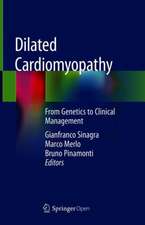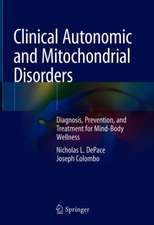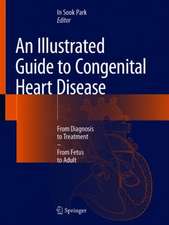Interventional Pericardiology: Pericardiocentesis, Pericardioscopy, Pericardial Biopsy, Balloon Pericardiotomy, and Intrapericardial Therapy
Autor Bernhard Maisch, Arsen D. Ristic, Petar M. Seferovic, Teresa S. M. Tsangen Limba Engleză Mixed media product – 24 mar 2011
Accordingly “Interventional Pericardiology” belongs in every medical library and on the desk of every cardiologist, cardiological interventionalist, and trainee with an interest in pericardial diseases.
Preț: 717.20 lei
Preț vechi: 754.95 lei
-5% Nou
137.25€ • 142.77$ • 113.31£
Carte disponibilă
Livrare economică 22 martie-05 aprilie
Specificații
ISBN-10: 3642113346
Pagini: 200
Ilustrații: XXII, 184 p. With DVD.
Dimensiuni: 168 x 240 x 10 mm
Greutate: 0.45 kg
Ediția:2011
Editura: Springer Berlin, Heidelberg
Colecția Springer
Locul publicării:Berlin, Heidelberg, Germany
Public țintă
Professional/practitionerCuprins
ForewordPrefaceAcknowledgmentsAuthors1.A Historical Perspective1.1.Introduction1.2.Diagnostic and therapeutic pericardial interventions1.2.1.Pericardiocentesis and pericardial drainage1.2.2.Pericardioscopy1.2.3.Pericardial biopsy1.2.4.Percutaneous balloon pericardiotomy1.2.5.Intrapericardial treatment of pericardial disease1.2.6.Intrapericardial treatment of non-pericardial disease1.3.Future perspectives and recommendations2.Anatomy of the Pericardium Relevant for Pericardial Access, Pericardioscopy, and Intrapericardial Interventions2.1.Introduction2.2.Structures of the normal pericardium2.2.1.Pericardial sinuses and recesses2.2.2.Epicardial and pericardial fat2.2.3.Normal pericardial fluid2.2.4.Nerves, arteries, lymphatics, and lymph nodes2.3.Pericardial anomalies2.4.Distinction between the human and animal pericardium2.5.Future perspectives and recommendations3.Pericardial Effusion and Cardiac Tamponade3.1.Introduction3.2.Clinical presentation of cardiac tamponade3.3.Physical findings in cardiac tamponade3.3.1.Pulsus paradoxus3.4.Electrocardiogram in cardiac tamponade3.5.Chest radiography3.6.Echocardiography3.7.Cardiac catheterization and invasive hemodynamics3.8.Medical management of cardiac tamponade3.9.Future perspectives and recommendations4.Pericardial Access and Drainage: Standard Techniques4.1.Introduction4.2.Indications for pericardial drainage4.3.Emergency pericardiocentesis4.4.Echocardiography-guided pericardiocentesis4.4.1.Evolution of echo-guided pericardiocentesis4.4.2.Safety and efficacy of echo-guided pericardiocentesis4.4.3.Reduction of effusion recurrence with catheter drainage4.4.4.Technique of state-of–the-art echo-guided pericardiocentesis4.5.Pericardiocentesis guided by fluoroscopy4.5.1.Feasibility of fluroscopy guided pericardiocentesis4.5.2.The role of cardiac catheterization during pericardiocentesis4.5.3.Safety of fluoroscopy guided pericardiocentesis4.6.Surgical drainage of the pericardium4.7.Future perspectives and recommendations5.Alternative Techniques for Pericardiocentesis5.1.Introduction5.2.Pericardiocentesis guided by epicardial halo phenomenon5.2.1.Physical origin of the sign5.2.2.Tangential approach to the pericardial surface5.2.3.Feasibility and safety5.2.4.Clinical implications5.3.PerDUCER® technique5.3.1.Endoscopic guidance in patients with perimyocarditis5.3.2.PerDUCER® procedure in patients with moderate/large effusions5.3.3.Potential improvements of the procedure5.4.PeriAttacher® and AttachGuider®5.5.Pericardial access using a blunt-tip needle5.6.Transbronchial approach5.7.Computer guided pericardiocentesis5.8.Pericardiocentesis guided by computed tomography5.9.Pericardiocentesis guided by a pacing capture5.10.Future perspectives and recommendations6.Pericardiocentesis in the Absence of Effusion6.1.Introduction6.2.Subxiphoid pericardiocentesis using a Tuohy needle and fluoroscopy6.2.1.Technique and potential complications6.2.2.Feasibility and safety6.2.3.Limitations of the approach6.3.The PerDUCER® technique6.3.1.Experimental experience6.3.2.Access of the human pericardium in the absence of effusion using PerDUCER6.4.Pericardial access via trans-atrial approach6.4.1.Catheter system with a pre-mounted needle6.4.2.Streamlined catheter system6.4.3.Safety of the transatrial approach6.4.4.Study limitations6.4.5.Clinical implications6.5.Right ventricular approach6.6.Future perspectives and recommendations7.Diagnostic Value of Pericardial Fluid Analyses7.1.Introduction7.2.Volume and appearance of pericardial effusion7.3.Pericardial fluid cytology7.3.1.Number of specimens needed for pericardial fluid cytology7.3.2.Detection of malignancy by pericardial fluid cytology7.3.3.Reactive mesothelial vs. adenocarcinoma cells7.3.4.Prognostic and therapeutic implications7.3.5.Paramalignant pericardial effusion7.3.6.Blood cells in pericardial effusion7.3.7.Staining for bacteria in pericardial effusion7.4.Biochemical analyses7.4.1.Differentiation of transudates and exudates7.4.2.Pericardial cytokines7.4.3.Adenosine deaminase activity in pericardial effusion7.5.Virology of pericardial effusion7.5.1.Polymerase chain reaction – PCR7.6.Bacteriology of pericardial effusion7.6.1.Bacteriology of pericardial effusion in tuberculous pericarditis7.6.2.Bacteriology of pericardial effusion in patients with AIDS7.7.Tumor markers7.7.1.Carcinoembryonic antigen – CEA7.7.2.Neuron-specific enolase – NSE7.7.3.Carbohydrate antigen 125 – CA1257.7.4.Alpha-fetoprotein7.8.Immunology of pericardial effusion7.8.1.Serodiagnosis of tuberculous pericarditis7.9.Future perspectives and recommendations8.Pericardioscopy: Endoscopic Insight into Pericardial Pathology8.1.Introduction8.2.Technical considerations8.3.Analysis of diagnostic value8.4.Feasibility and safety8.5.Future perspectives and recommendations9.Epicardial and Pericardial Biopsy9.1.Introduction9.2.Technique9.2.1.Pericardial biopsy guided by fluoroscopy9.2.2.Pericardial and epicardial biopsy targeted by pericardioscopy9.3.Sampling efficiency and histological findings9.4.Sensitivity of pericardial biopsy:a key issue for the successful clinical application9.5.Diagnostic value9.6.The analyses of the epicardial and pericardial biopsy samples9.6.1.Processing techniques9.6.2.Molecular biology techniques9.6.3.Immunohistochemistry of epicardial biopsies9.7.Safety and complications9.8.Future perspectives and recommendations10.Intrapericardial Treatment of Pericardial Disease10.1.Introduction10.2.Intrapericardial treatment of neoplastic pericarditis10.2.1.Cisplatin10.2.2.Thiotepa10.2.3.Alternative agents10.3.Intrapericardial treatment of autoreactive pericarditis10.4.Intrapericardial treatment of uremic pericarditis10.5.Intrapericardial treatment of purulent pericarditis10.6.Future perspectives and recommendations11.Percutaneous Balloon Pericardiotomy11.1.Introduction11.2.Indications and contraindications11.3.Methodological considerations11.4.Mechanism of action11.5.Balloon catheter selection11.6.Multicenter analysis of feasibility and long-term results11.7.Safety11.8.Future perspectives and recommendations12.Frontiers and Emerging Procedures12.1.Introduction12.2.Intrapericardial echocardiography12.3.Intrapericardial treatment of non-pericardial diseases12.3.1.Potential advantages of intrapericardial approach12.3.2.Possible drawbacks of intrapericardial pharmacokinetics12.3.3.Intrapericardial application of coronary vasodilators12.3.4.Intrapericardial anti-arrhythmic therapy12.3.5.Intrapericardial prevention of restenosis12.3.6.Intrapericardial gene therapy12.3.7.Intrapericardial application of growth factors12.3.8.Intrapericardial application of stem cells12.3.9.Intrapericardial treatment of ventricular rupture12.4.Ambulatory pericardial drainage using a permanent port system12.5.The Heart-Lander® – intrapericardial crawling robotic device12.6.Epicardial mapping and radiofrequent ablation12.7.Future perspectives and recommendationsINDEX
Textul de pe ultima copertă
Interventional Pericardiology gives a unique and comprehensive view on an often neglected but clinically very important part of cardiovascular disease: The pericardium and the adjacent myocardium or epicardium. The authors of this up-to-date compendium on pericardial disease etiology, diagnostics and treatment, Professors Bernhard Maisch (Marburg), Arsen Ristic (Belgrade), Petar Seferovic (Belgrade) and Teresa Tsang (Rochester) focus on recent advances to the new window that has been opened to the heart by flexible and video-assisted pericardioscopy, modern biochemical, immunohistological and molecular tools for the analysis of epicardial and pericardial biopsies, which have been acquired safely under pericardioscopic control by the interventional pericardiologist. Their book adds brand-new information to the recent and so far only guidelines world-wide by the European Society of Cardiology on the management of pericardial diseases. This task-force has been chaired by the lead author B. Maisch. Accordingly “Interventional Pericardiology” belongs in every medical library and on the desk of every cardiologist, cardiological interventionalist, and trainee with an interest in pericardial diseases.
Caracteristici
Descriere
Interventional Pericardiology gives a unique and comprehensive view on an often neglected but clinically very important part of cardiovascular disease: The pericardium and the adjacent myocardium or epicardium. The authors of this up-to-date compendium on pericardial disease etiology, diagnostics and treatment, Professors Bernhard Maisch (Marburg), Arsen Ristić (Belgrade), Petar Seferović (Belgrade) and Teresa Tsang (Rochester) focus on recent advances to the new window that has been opened to the heart by flexible and video-assisted pericardioscopy, modern biochemical, immunohistological and molecular tools for the analysis of epicardial and pericardial biopsies, which have been acquired safely under pericardioscopic control by the interventional pericardiologist. Their book adds brand-new information to the recent and so far only guidelines world-wide by the European Society of Cardiology on the management of pericardial diseases. This task-force has been chaired by the lead author B. Maisch.
Accordingly “Interventional Pericardiology” belongs in every medical library and on the desk of every cardiologist, cardiological interventionalist, and trainee with an interest in pericardial diseases.

























